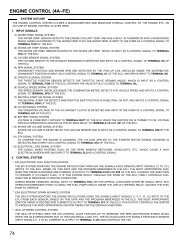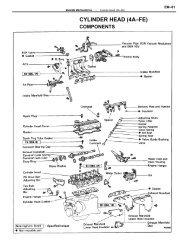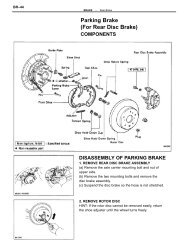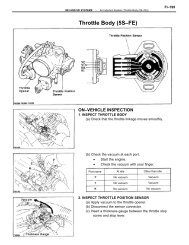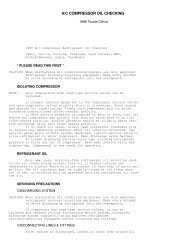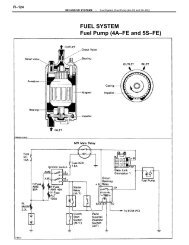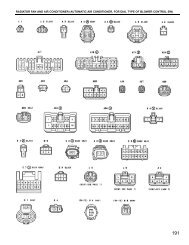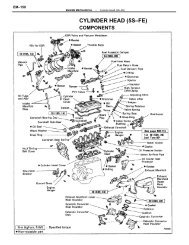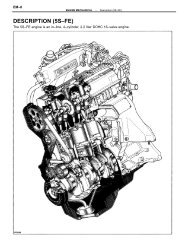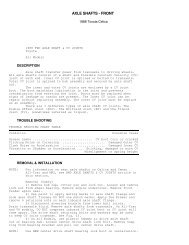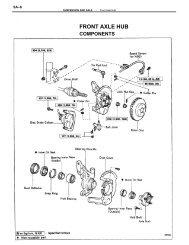A240E Diagnosis - CelicaTech
A240E Diagnosis - CelicaTech
A240E Diagnosis - CelicaTech
Create successful ePaper yourself
Turn your PDF publications into a flip-book with our unique Google optimized e-Paper software.
Page 1 of 57<br />
ARTICLE BEGINNING<br />
APPLICATION<br />
APPLICATION<br />
Vehicle<br />
Celica 2.2L (1993)<br />
Corolla 1.8L<br />
MR2<br />
Paseo<br />
Prizm (LSi)<br />
Transmission Model<br />
A-241E<br />
A-245E<br />
A-241E<br />
A-244E<br />
A-245E<br />
CAUTION:<br />
All models are equipped with a Supplemental Restraint System<br />
(SRS). When servicing vehicle, use care to avoid accidental air bag<br />
deployment. All SRS electrical connections and wiring harness are<br />
covered by Yellow insulation. SRS-related components are located<br />
in the steering column, center console, instrument panel and lower<br />
panel on instrument panel. DO NOT use electrical test equipment on<br />
these circuits. If necessary, deactivate the SRS before servicing<br />
components. For 1993 Geo Prizm, see AIR BAG RESTRAINT<br />
SYSTEM . For 1993 Toyota Celica, see AIR BAG RESTRAINT<br />
SYSTEM . For 1993 Toyota Corolla, see AIR BAG RESTRAINT<br />
SYSTEM . For 1993 Toyota MR2, see AIR BAG RESTRAINT SYSTEM .<br />
For 1993 Toyota Paseo, see AIR BAG RESTRAINT SYSTEM . in the<br />
ACCESSORIES/SAFETY EQUIP.<br />
DESCRIPTION<br />
The A-240 "E" series automatic transmission is electronically controlled. Transmission shifting<br />
and torque converter lock-up are controlled by an Electronic Controlled Transmission (ECT)<br />
Electronic Control Unit (ECU). Control unit is referred to as the ECT ECU.<br />
NOTE:<br />
ECT ECU is combined with the engine ECU into one unit. This<br />
control unit is referred to as the engine and ECT ECU. See Fig. 1 -<br />
Fig. 8 . In this article, control unit will be referred to as the ECT ECU<br />
on all models.<br />
The ECT ECU receives information from various input devices and uses this information to<br />
control No. 1 and No. 2 solenoids for transmission shifting and lock-up solenoid for torque<br />
converter lock-up.<br />
A pattern select switch is located on center console (1993 Celica 2.2L). Pattern select switch<br />
contains a POWER (depressed) and a NORMAL (released) operating position. When pattern select<br />
switch is depressed, transmission upshifts and downshifts will occur at a higher vehicle speed than<br />
with switch released. An indicator light will indicate the pattern select switch position.
Page 2 of 57<br />
An Overdrive (OD) switch is mounted on the shift lever. See Fig. 1 -Fig. 8 . When OD switch is<br />
depressed to ON position, transmission will shift into 4th gear when shift lever is in "D" position,<br />
and OD OFF light on instrument panel will go off. When OD switch is released to OFF position,<br />
transmission will shift into 3rd gear, and OD OFF light on instrument panel will illuminate.<br />
Transmission is equipped with a shift lock and key lock system. Shift lock system prevents shift<br />
lever from being moved from Park unless brake pedal is depressed. In case of a malfunction, shift<br />
lever can be released by depressing shift lock override button, located near shift lever. Key lock<br />
system prevents ignition key from being moved from ACC to LOCK position on ignition switch<br />
unless shift lever is in Park. For more information on shift lock and key lock system, see the<br />
SHIFT LOCK SYSTEM article.<br />
OPERATION<br />
ELECTRONIC CONTROLLED TRANS. ELECT. CONTROL UNIT (ECT ECU)<br />
1.<br />
2.<br />
The ECT ECU receives information from various input devices and uses this information to<br />
control No. 1, No. 2 and lock-up solenoids. The ECT ECU contains a self-diagnostic system,<br />
which will store code if failure or problem exists in the electronic control system.<br />
Code can be retrieved to determine transmission problem area. See SELF-DIAGNOSTIC<br />
SYSTEM . On Corolla, Celica, Paseo and Prizm ECU is located near front of center<br />
console. See Fig. 1 -Fig. 6 . On MR2 models, ECT ECU is located near left rear corner of<br />
engine compartment. See Fig. 7 and Fig. 8 .
Page 3 of 57<br />
Fig. 1: Input & Output Devices (Corolla Shown, Prizm Is Similar)<br />
Courtesy of TOYOTA MOTOR SALES, U.S.A., INC.<br />
Fig. 2: Input & Output Devices (Corolla Shown, Prizm Is Similar)<br />
Courtesy of TOYOTA MOTOR SALES, U.S.A., INC.
Fig. 3: Input & Output Devices (1993 Celica Shown, 1994 Celica Is Similar)<br />
Courtesy of TOYOTA MOTOR SALES, U.S.A., INC.<br />
Page 4 of 57
Fig. 4: Input & Output Devices (1993 Celica Shown, 1994 Celica Is Similar)<br />
Courtesy of TOYOTA MOTOR SALES, U.S.A., INC.<br />
Page 5 of 57
Fig. 5: Input & Output Devices (Paseo)<br />
Courtesy of TOYOTA MOTOR SALES, U.S.A., INC.<br />
Page 6 of 57
Fig. 6: Input & Output Devices (Paseo)<br />
Courtesy of TOYOTA MOTOR SALES, U.S.A., INC.<br />
Page 7 of 57
Fig. 7: Input & Output Devices (MR2)<br />
Courtesy of TOYOTA MOTOR SALES, U.S.A., INC.<br />
Page 8 of 57
Page 9 of 57<br />
Fig. 8: Input & Output Devices (MR2)<br />
Courtesy of TOYOTA MOTOR SALES, U.S.A., INC.<br />
ECT ECU INPUT DEVICES<br />
Pattern Select Switch<br />
Pattern select switch delivers an input signal to ECT ECU to indicate transmission shift points<br />
selected by the operator. Pattern select switch is located near shift lever (1993 Celica models).<br />
Park/Neutral Position Switch<br />
Park/Neutral position switch delivers an input signal to ECT ECU to indicate shift lever position.<br />
Park/Neutral position switch is located on side of transmission. See Fig. 1 -Fig. 8 .
Page 10 of 57<br />
Throttle Position Sensor<br />
Throttle position sensor delivers an input signal to ECT ECU indicating throttle position. Throttle<br />
position sensor is located on side of throttle body.<br />
Vehicle Speed Sensor<br />
Vehicle speed signal is delivered to ECT ECU by speed sensors. Speed sensors are located on<br />
transmission and in combination meter on some models.<br />
Brakelight Switch<br />
Brakelight switch delivers input signal to ECT ECU, indicating vehicle braking. Brakelight switch<br />
is located on brake pedal support.<br />
OD Switch<br />
The OD switch provides an input signal to ECT ECU to indicate when overdrive is selected by the<br />
operator. When OD switch is depressed to ON position, transmission will shift into 4th gear when<br />
shift lever is in "D" position, and OD OFF light on instrument panel will go off. See Fig. 1 -Fig. 8 .<br />
When OD switch is released to OFF position, transmission will shift into 3rd gear, and OD OFF<br />
light on instrument panel will come on. The OD switch is mounted on the shift lever.<br />
Coolant Temperature Sensor<br />
Coolant temperature sensor delivers input signal to ECT ECU, indicating engine coolant<br />
temperature. Coolant temperature sensor is located in thermostat housing or radiator<br />
Cruise Control Electronic Control Unit (ECU)<br />
Cruise control ECU delivers an input signal to control overdrive operation in accordance with<br />
vehicle speed when cruise control is operating. When in overdrive with cruise control on, if vehicle<br />
speed drops 3 MPH less than the set speed, overdrive is released to prevent reduction in vehicle<br />
speed. Once vehicle speed is more than the set speed, the overdrive is resumed. Cruise control<br />
ECU is located behind instrument panel on passenger's side. See Fig. 1 -Fig. 6 .<br />
NOTE:<br />
Cruise control ECU may be referred to as cruise control computer.<br />
ECT ECU OUTPUT DEVICES<br />
No. 1 & No. 2 Solenoids<br />
The ECU controls transmission shifting by delivering an output signal to operate proper solenoid.<br />
Solenoids are operated in accordance with shift lever range. See Fig. 9 . If a solenoid malfunctions,<br />
designated gear may result. See Fig. 9 . Solenoids are located on transmission. See Fig. 1 -Fig. 8 .
Page 11 of 57<br />
Fig. 9: Determining No. 1 & No. 2 Solenoid Operation<br />
Courtesy of TOYOTA MOTOR SALES, U.S.A., INC.<br />
Lock-Up Solenoid<br />
ECU controls torque converter lock-up on all "E" series models by delivering an output signal to<br />
lock-up solenoid. Lock-up solenoid is activated when shift lever is in "D" position and vehicle is at<br />
specified speed. Lock-up solenoid is located on transmission. See Fig. 1 -Fig. 8 .<br />
TROUBLE SHOOTING<br />
* PLEASE READ THIS FIRST *<br />
NOTE:<br />
If problem area is not listed under symptom trouble shooting, check<br />
throttle position sensor signal, brake signal, gear signal and ECT<br />
ECU voltages.<br />
TRANSMISSION WILL NOT SHIFT<br />
1.<br />
2.<br />
3.<br />
Warm engine to normal operating temperature. Connect voltmeter between terminals TT and<br />
E1 of DLC1 connector. Refer to the Fig. 10 -11. Turn ignition on. Note that voltage changes<br />
as throttle pedal is depressed.<br />
If voltage changes with throttle opening, go to step 6). If voltage does not change with<br />
throttle opening, go to next step. Access ECT ECU. See Fig. 1 -Fig. 8 .<br />
Connect voltmeter between terminals B/K and E1 on ECT ECU connector. See Fig. 22 . No<br />
voltage should exist with brake pedal released. Approximately 10-14 volts should exist with<br />
brake pedal depressed.
Page 12 of 57<br />
4.<br />
5.<br />
6.<br />
7.<br />
8.<br />
9.<br />
If voltage is not as specified, check for defective brakelight switch. If brakelight switch is<br />
okay, inspect and repair circuit between brakelight switch and ECT ECU. See appropriate<br />
wiring diagram in WIRING DIAGRAMS .<br />
If voltage is correct, check for defective ECT ECU power source or ground connections.<br />
Check for short or open circuit in wire to TT terminal of DLC connector. Check for<br />
defective throttle position sensor or wiring. See THROTTLE POSITION SENSOR (TPS)<br />
COMPONENT TEST under COMPONENT TESTING.<br />
Perform MANUAL SHIFTING TEST under SYSTEM TESTING. If transmission does not<br />
perform correctly, disassemble and inspect transmission. If transmission operates correctly,<br />
road test vehicle and ensure voltage at terminal TT increases from zero to 7 volts. See<br />
GEAR SIGNAL under ELECTRICAL TESTING.<br />
If no voltage exists, go to step 9 . If voltage increases from zero to 7 volts, transmission or<br />
solenoids are faulty. If voltage increases from zero to 4 volts, perform NO UPSHIFT TO<br />
OVERDRIVE under TROUBLE SHOOTING.<br />
If voltage increases from zero to 2 volts, check for 10-14 volts between terminals 2 and E1<br />
on ECT ECU with connector connected and shift lever in "D" position. See Fig. 22 . If 10-14<br />
volts exist, check for defective park/neutral position switch. If switch is okay, inspect and<br />
repair circuit(s) between switch and ECT ECU. See appropriate wiring diagram in WIRING<br />
DIAGRAMS . If 10-14 volts does not exist, replace ECT ECU.<br />
Check for 10-14 volts between terminals "L" and E1 on the ECT ECU with the connector<br />
connected and shift lever in "D" position. See Fig. 22 . If 10-14 volts exist, check for<br />
defective park/neutral position switch. If switch is okay, inspect and repair circuit(s)<br />
between switch and ECT ECU. Refer to the appropriate wiring diagram in WIRING<br />
DIAGRAMS . If 10-14 volts do not exist, replace ECT ECU.<br />
SHIFT POINTS TOO HIGH OR LOW<br />
1.<br />
2.<br />
3.<br />
4.<br />
5.<br />
6.<br />
7.<br />
Warm engine to normal operating temperature. Connect voltmeter between terminals TT and<br />
E1 of DLC1 connector. Refer to the Fig. 10 -11.<br />
Turn ignition on. Depress and release throttle pedal. Note if voltage changes with throttle<br />
opening. If voltage changes with throttle opening, go to step 6). If voltage does not change<br />
with throttle opening, go to next step.<br />
Access ECT ECU. See Fig. 1 -Fig. 8 . Connect voltmeter between terminals B/K and E1 on<br />
ECT ECU with connector connected. See Fig. 22 .<br />
No voltage should exist with brake pedal released. Approximately 10-14 volts should exist<br />
with brake pedal depressed. If voltage is not as specified, check for defective brakelight<br />
switch or wiring circuit.<br />
If voltage is as specified, check for defective ECT ECU power source or ground<br />
connections. See appropriate wiring diagram in WIRING DIAGRAMS . Check for short or<br />
open circuit in wire to TT terminal of DLC connector. See THROTTLE POSITION<br />
SENSOR SIGNAL under ELECTRICAL TESTING and the appropriate wiring diagram<br />
under WIRING DIAGRAMS . Check for defective throttle position sensor or wiring.<br />
On 1993 Celica, connect voltmeter between terminals P and E1 on ECT ECU with connector<br />
connected. See Fig. 22 . Check voltage with pattern select switch in POWER (depressed)<br />
and NORMAL (released) operating positions (if applicable).<br />
Voltage should be 10-14 volts with switch in POWER position and one volt with switch in<br />
NORMAL position. If voltage is as specified, ECT ECU or transmission is defective. If
Page 13 of 57<br />
voltage is not as specified, check for defective pattern select switch or wiring circuit. See<br />
PATTERN SELECT SWITCH under COMPONENT TESTING.<br />
NO UPSHIFT TO OVERDRIVE<br />
1.<br />
2.<br />
3.<br />
4.<br />
5.<br />
6.<br />
7.<br />
8.<br />
9.<br />
10.<br />
11.<br />
12.<br />
Warm engine to normal operating temperature. With ignition off, disconnect solenoid<br />
harness connector from transmission. Electrical connectors are located near park/neutral<br />
position switch on transmission.<br />
Road test vehicle and note if transmission upshifts to overdrive. Reconnect harness<br />
connector. Clear codes from ECU memory, as disconnecting electrical connectors may set<br />
codes. Refer to CLEARING FAULT CODES . If no overdrive upshift exists, disassemble<br />
and inspect transmission. If overdrive upshift exists, go to next step.<br />
Connect voltmeter between terminals TT and E1 of DLC connector. See Fig. 10 and Fig.<br />
11 . Road test vehicle and ensure voltage at terminal TT increases from zero to 7 volts. See<br />
GEAR SIGNAL under ELECTRICAL TESTING.<br />
If no voltage exists, check for 10-14 volts between terminals L and E1 on ECT ECU with<br />
the connector connected, the shift lever in the "D" position and with ignition on. See Fig.<br />
22 . If 10-14 volts exist, check for defective park/neutral position switch. Refer to<br />
PARK/NEUTRAL POSITION (PNP) SWITCH under COMPONENT TESTING.<br />
If switch is okay, inspect and repair circuit(s) between switch and ECT ECU. See<br />
appropriate wiring diagram in WIRING DIAGRAMS . If 10-14 volts does not exist,<br />
replace ECT ECU.<br />
If voltage increases from zero to 2 volts, check for 10-14 volts between terminals 2 and E1<br />
on ECT ECU with connector connected, shift lever in "D" position and ignition on.<br />
If 10-14 volts exist, check for defective park/neutral position switch. If switch is okay,<br />
inspect and repair circuit(s) between switch and ECT ECU. See appropriate wiring diagram<br />
in WIRING DIAGRAMS. If 10-14 volts does not exist, replace ECT ECU.<br />
If voltage increases from zero to 7 volts between terminals L and E1, solenoids may be<br />
faulty. See SOLENOIDS under COMPONENT TESTING. If solenoids are okay,<br />
disassemble and inspect transmission. If voltage increases from zero to 4 volts between<br />
terminals L and E1, connect voltmeter between terminals OD2 and E1 on ECT ECU with<br />
connector connected. See Fig. 22 .<br />
Turn ignition on. Check voltage with OD switch on the shift lever released (OFF position)<br />
and depressed (ON position). No voltage should exist with switch released and 10-14 volts<br />
should exist with switch depressed.<br />
If voltage is correct, go to next step. If voltage is not as specified, check for defective OD<br />
switch or wiring circuit.<br />
Check voltage between terminals OD1 and E1 on ECT ECU with connector connected and<br />
ignition on. Voltage should be approximately 5 volts. If voltage is correct, replace ECT<br />
ECU. If voltage is not correct, go to next step.<br />
Disconnect electrical connector from cruise control ECU. See Fig. 1 -Fig. 8 . Check voltage<br />
between terminals OD1 and E1 on ECT ECU with connector connected and with ignition<br />
on. If voltage is approximately 5 volts, replace cruise control ECU. If voltage is not within<br />
specification 5 volts, inspect and repair circuit(s) between cruise control ECU and ECT<br />
ECU. See appropriate wiring diagram in WIRING DIAGRAMS . If wiring is okay, replace<br />
ECT ECU.
Page 14 of 57<br />
NO LOCK-UP<br />
1.<br />
2.<br />
3.<br />
4.<br />
5.<br />
Warm engine to normal operating temperature. Connect voltmeter between terminals TT and<br />
E1 of DLC connector. Refer to the Fig. 10 and Fig. 11 .<br />
Road test vehicle and ensure voltage at terminal TT is 7 volts in lock-up range. See GEAR<br />
SIGNAL under ELECTRICAL TESTING. If voltage is correct, lock-up solenoid, torque<br />
converter or transmission is defective.<br />
If voltage is not as specified, access ECT ECU. Refer to the Fig. 1 -Fig. 8 . Connect<br />
voltmeter between terminals B/K and E1 on ECT ECU with connector connected. See Fig.<br />
22 .<br />
No voltage should exist with brake pedal released. Approximately 10-14 volts should exist<br />
with brake pedal depressed. If voltage is not as specified, check for defective brakelight<br />
switch or wiring circuit.<br />
If voltage is as specified, check for defective ECT ECU power source or ground<br />
connections. See appropriate wiring diagram in WIRING DIAGRAMS. Check for short or<br />
open circuit in wire to TT terminal of check connector. Check for defective throttle position<br />
sensor or wiring. See THROTTLE POSITION SENSOR (TPS) COMPONENT TEST<br />
under COMPONENT TESTING.<br />
SELF-DIAGNOSTIC SYSTEM<br />
SYSTEM DIAGNOSIS<br />
NOTE:<br />
Before testing transmission, ensure fluid level is correct and throttle<br />
and shift cables are properly adjusted. Ensure engine starts with<br />
shift lever in Park and Neutral to ensure proper adjustment of neutral<br />
start switch. Transmission must first be tested by checking for<br />
stored codes. Refer to RETRIEVING CODES .<br />
ECT ECU monitors transmission operation and contains a self-diagnostic system which stores<br />
code if transmission electronic control system failure or problem exists. If a problem exists in No.<br />
1 or No. 2 solenoids or speed sensors and code is set, ECT ECU blinks OD OFF light on<br />
instrument panel to warn driver.<br />
OD OFF light on instrument panel will not blink to warn driver if a problem exists or code is<br />
stored for lock-up solenoid, or problem exists with brakelight switch signal or throttle position<br />
sensor signal.<br />
RETRIEVING CODES<br />
NOTE:<br />
Before retrieving codes, ensure proper battery voltage exists for<br />
proper self-diagnosis system operation. Perform diagnostic circuit<br />
check before retrieving codes to ensure proper operation of OD OFF<br />
light. See DIAGNOSTIC CIRCUIT CHECK heading below.<br />
Diagnostic Circuit Check
Page 15 of 57<br />
1.<br />
2.<br />
Turn ignition on. Release OD switch on shift lever to OFF position. Ensure OD OFF light on<br />
instrument panel turns on. If OD OFF light does not illuminate, check OD switch and wiring<br />
circuit.<br />
Depress OD switch to ON position. Ensure OD OFF light on instrument panel goes off. If<br />
OD OFF light remains on, check OD switch and wiring circuit. If OD OFF light is blinking,<br />
check for stored codes. See ECT ECU CODES heading below.<br />
ECT ECU Codes<br />
1.<br />
Turn ignition on. DO NOT start engine. Depress OD switch on shift lever to ON position.<br />
NOTE:<br />
Codes can only be retrieved with OD switch on. If OD switch is<br />
off, OD OFF light will be on continuously and will not blink the<br />
code.<br />
2.<br />
3.<br />
4.<br />
5.<br />
6.<br />
7.<br />
Install jumper wire between terminals TE1 and E1 of DLC1 connector. See Fig. 10 and Fig.<br />
11 .<br />
Note number of flashes from OD OFF light on instrument panel. If normal system operation<br />
exists, OD OFF light will flash once every .25 second. See Fig. 12 -13.<br />
If system is operating correctly and no code exists, turn ignition off and remove jumper wire.<br />
Perform MANUAL SHIFTING TEST under SYSTEM TESTING to determine if problem<br />
is a electrical or mechanical transmission problem. Check system by the symptom. See<br />
appropriate symptom under TROUBLE SHOOTING .<br />
If code exists, OD OFF light will blink once every .5 second. Number of blinks equals first<br />
digit of code. After a pause of 1.5 seconds, second digit will be displayed. See Fig. 12 -13.<br />
If more than one code exists, next code will be displayed after pause of 2.5 seconds. See Fig.<br />
12 -13. Smallest number code will display first and system will progress to largest code.<br />
Codes will be repeated.<br />
Once code is obtained, determine probable cause and symptom. See CODE<br />
IDENTIFICATION table. For diagnosis and repair of codes, see DIAGNOSTIC<br />
TESTING . Turn ignition off and remove jumper wire.<br />
NOTE:<br />
Once repairs have been performed, codes must be cleared from ECT<br />
ECU memory. See CLEARING FAULT CODES .<br />
CODE IDENTIFICATION<br />
Fault Code<br />
(1) Probable Cause<br />
42<br />
(2) Defective No. 1 Speed Sensor<br />
61<br />
(2) Defective No. 2 Speed Sensor<br />
62 Defective No. 1 Solenoid<br />
63 Defective No. 2 Solenoid<br />
64 Defective Lock-Up Solenoid<br />
(1) Check listed component for probable cause. Also check wiring and connections of<br />
specified component.
Page 16 of 57<br />
Fault Code<br />
(1) Probable Cause<br />
(2) If both No. 1 and No. 2 speed sensors fail simultaneously, fault code will not exist, but<br />
transmission will not upshift from 1st gear with shift lever in "D" position.<br />
Fig. 10: DLC1 Connector Terminals<br />
Courtesy of TOYOTA MOTOR SALES, U.S.A., INC.
Fig. 11: DLC1 Connector Terminals<br />
Courtesy of TOYOTA MOTOR SALES, U.S.A., INC.<br />
Page 17 of 57
Fig. 12: Fault Code Displays<br />
Courtesy of TOYOTA MOTOR SALES, U.S.A., INC.<br />
Page 18 of 57
Page 19 of 57<br />
Fig. 13: Fault Code Displays<br />
Courtesy of TOYOTA MOTOR SALES, U.S.A., INC.<br />
CLEARING FAULT CODES<br />
1.<br />
2.<br />
3.<br />
Once repairs have been performed, fault codes must be cleared from ECU memory. Remove<br />
EFI fuse (15-amp) from engine compartment fuse box for 10 seconds to clear memory in<br />
ECU.<br />
On MR2, engine compartment fuse box is located on driver's side of engine compartment.<br />
On Celica, Corolla and Paseo, engine compartment fuse box is located near the battery in<br />
engine compartment.<br />
Fuse may need to be removed for more than 10 seconds in cold ambient temperatures.<br />
Reinstall fuse.<br />
NOTE:<br />
Fault codes may also be cleared by disconnecting negative battery<br />
cable, but memory for electronic components will be also be<br />
canceled.<br />
SYSTEM TESTING<br />
MANUAL SHIFTING TEST
Page 20 of 57<br />
NOTE:<br />
Perform manual shifting test if no fault codes exist. Manual shifting<br />
test determines if problem area is in electrical circuits or a<br />
mechanical transmission problem.<br />
1.<br />
2.<br />
3.<br />
4.<br />
With ignition off, disconnect electrical connector from solenoids on transmission. Electrical<br />
connector is located near neutral start switch on transmission.<br />
Road test vehicle and ensure transmission gear changes corresponds with shift lever<br />
position. See GEAR APPLICATION table. If abnormality exists, a mechanical<br />
transmission problem exists.<br />
If all gears are correct, perform trouble shooting in accordance with the symptom. See<br />
TROUBLE SHOOTING . Turn ignition off.<br />
Reconnect electrical connector. Clear fault codes from ECU memory. See CLEARING<br />
FAULT CODES .<br />
GEAR APPLICATION<br />
Shift Lever Position<br />
Transmission Gear<br />
D<br />
Overdrive<br />
2 3rd Gear<br />
L<br />
1st Gear<br />
R<br />
Reverse<br />
P<br />
Park<br />
TORQUE CONVERTER LOCK-UP<br />
NOTE:<br />
Refer to appropriate SHIFT SPEED SPECIFICATION table in the<br />
appropriate AUTO TRANS OVERHAUL article for lock-up shift speed.<br />
Refer to the following:<br />
• For A-240E, A-240L, A244L & A-245E transaxles, see: AUTO TRANS OVERHAUL - A-<br />
240E/L, A-244L & A-245E<br />
• For A-241E, A-241H, A241L & A-243E transaxles, see: AUTO TRANS OVERHAUL - A<br />
-241E/H/L & A-243E<br />
Road test vehicle. Increase vehicle speed until lock-up should occur. To confirm lock-up<br />
operation, very lightly depress brake pedal with left foot and release while maintaining constant<br />
speed. Monitor vehicle tachometer. Torque converter should release and then return to lock-up<br />
once brake pedal is released.<br />
ELECTRICAL TESTING<br />
* PLEASE READ THIS FIRST *<br />
NOTE:<br />
All voltage checks are made with ignition switch in ON position<br />
unless otherwise stated.
Page 21 of 57<br />
THROTTLE POSITION SENSOR SIGNAL<br />
1.<br />
2.<br />
3.<br />
Locate DLC1 connector in engine compartment. Refer to the Fig. 10 and Fig. 11 . Connect<br />
voltmeter between terminals TT and E1 of DLC connector. See Fig. 10 and Fig. 11 .<br />
Turn ignition on. Note that voltage gradually increases as accelerator is depressed. Voltage<br />
should gradually increase to about 6 volts with throttle fully open.<br />
If voltage does not change with throttle opening, check throttle position sensor. See<br />
THROTTLE POSITION SENSOR (TPS) COMPONENT TEST under COMPONENT<br />
TESTING. If throttle position sensor is okay, check wiring circuit for throttle position<br />
sensor.<br />
BRAKE SIGNAL<br />
1.<br />
2.<br />
3.<br />
Locate check connector in engine compartment. Refer to the Fig. 1 -2. Connect voltmeter<br />
between terminals TT and E1 of check connector. See Fig. 5 -8.<br />
Depress accelerator pedal until 6 volts exists. Depress brake pedal and note that voltage<br />
decreases to no voltage. Release brake pedal and note that voltage increases to 6 volts.<br />
If voltage is not as specified, check brakelight switch. See BRAKELIGHT SWITCH<br />
COMPONENT TEST under COMPONENT TESTING. If brakelight switch is okay, check<br />
wiring circuit for brakelight switch.<br />
GEAR SIGNAL<br />
1.<br />
2.<br />
3.<br />
4.<br />
Warm engine to normal operating temperature. On Celica models, place pattern select<br />
switch in NORMAL (released position). Pattern select switch is located near shift lever.<br />
On all models, depress OD switch, mounted on shift lever, to the ON position. Locate check<br />
connector in engine compartment. See Fig. 1 -2. Connect voltmeter between terminals TT<br />
and E1 of check connector. See Fig. 10 and Fig. 11 .<br />
Road test the vehicle with the shift lever in the "D" position and with vehicle speed greater<br />
than 6 MPH. Voltage should increase as specified in accordance with transmission gear<br />
position. See the GEAR SIGNAL VOLTAGES table.<br />
If voltages are as specified, electronic control system is operating correctly. If voltages are<br />
not as specified, system must be checked.<br />
GEAR SIGNAL VOLTAGES<br />
Gear Position<br />
Voltage (Approximate)<br />
1st Gear 0<br />
2nd Gear 2<br />
3rd Gear 4<br />
Overdrive 6<br />
Overdrive With Lock-Up 7<br />
OVERDRIVE CANCEL SIGNAL
Page 22 of 57<br />
1.<br />
2.<br />
Access ECT ECU. See Fig. 1 -8. Turn ignition on. Measure voltage (backprobe) between<br />
terminal OD1 of ECT ECU harness connector and ground. If battery voltage is present,<br />
substitute known good ECU and retest. If battery voltage is not present, go to next step.<br />
Turn ignition off. Disconnect cruise control ECU harness connector. See Fig. 1 -Fig. 8 .<br />
Turn ignition on. Measure voltage between terminal OD and ground. See Fig. 14 . If battery<br />
voltage is present, replace cruise control ECU and retest. If battery voltage is not present,<br />
inspect and repair circuit between cruise control ECU and ECT ECU.<br />
Fig. 14: Cruise Control ECU Terminals<br />
Courtesy of TOYOTA MOTOR SALES, U.S.A., INC.<br />
ECT ECU VOLTAGES<br />
Access ECT ECU. See Fig. 1 -Fig. 8 . Turn ignition on. Using voltmeter, backprobe ECT ECU<br />
harness connector. Check voltage between selected terminal and E1 or E2 terminal. Voltage should<br />
be as specified. See Fig. 22 .<br />
DIAGNOSTIC TESTING
Page 23 of 57<br />
INTRODUCTION<br />
When trouble shooting transmission, first check for stored codes and repair as necessary. If no<br />
codes exist, perform manual shifting test to determine if problem area is in electrical circuits or a<br />
mechanical transmission problem. See MANUAL SHIFTING TEST under SYSTEM TESTING.<br />
CODE NO. 42 (NO. 1 VEHICLE SPEED SENSOR (VSS)<br />
Celica (1993) & Paseo<br />
1.<br />
2.<br />
3.<br />
Determine if speedometer is operating properly. Inspect and repair speedometer drive gear,<br />
cable and combination meter as needed.<br />
Turn ignition off. Access ECT ECU harness connector. See Fig. 3 -Fig. 6 . Lift and support<br />
front wheels of vehicle. Backprobing ECT ECU harness connector with DVOM. Check<br />
voltage between SPD terminal and vehicle ground while turning front wheel.<br />
If voltage pulses as wheel is turned, replace ECT ECU and retest. If pulse is not present, turn<br />
ignition off. Remove combination meter. Connect ohmmeter to test terminals and rotate<br />
meter shaft. See Fig. 15 . If ohmmeter pulses, inspect and repair circuits between<br />
combination meter and ECT ECU. See appropriate wiring diagram in WIRING<br />
DIAGRAMS . If ohmmeter does not pulse, replace combination meter and retest.<br />
Fig. 15: Checking No. 1 Speed Sensor<br />
Courtesy of TOYOTA MOTOR SALES, U.S.A., INC.
Page 24 of 57<br />
Fig. 16: Checking No. 1 Speed Sensor<br />
Courtesy of TOYOTA MOTOR SALES, U.S.A., INC.<br />
Celica (1994), Corolla, MR2 & Prizm<br />
1.<br />
Lift and support vehicle. Disconnect cruise control ECU. See Fig. 1 -Fig. 8 . Remove<br />
combination meter. Turn ignition on. Using DVOM, measure voltage between SPD terminal<br />
of combination meter connector and ground. Refer to SPD CIRCUIT IDENTIFICATION<br />
table. Also, see Fig. 17 -Fig. 21 . Rotate front wheel.<br />
SPD CIRCUIT IDENTIFICATION<br />
Application<br />
Terminal No.<br />
Corolla 9<br />
Celica 3<br />
MR2 10<br />
Prizm 12<br />
2.<br />
3.<br />
If voltage pulses 0-5 volts, check continuity between ECT ECU harness connector E1<br />
terminal and ground. If continuity does not exist, inspect and repair circuit as needed. If<br />
continuity does exist, replace ECT ECU and retest. If no voltage is present, go to next step.<br />
If voltage is 4-6 volts and remains unchanged, go to step 5).<br />
Turn ignition off. Disconnect ECT ECU harness connector. See Fig. 1 -Fig. 8 . Using<br />
ohmmeter, check continuity between combination meter harness connector SPD terminal
Page 25 of 57<br />
4.<br />
5.<br />
6.<br />
and ECU SPD terminal. Refer to the Fig. 22 . If continuity exists, go to next step. If<br />
continuity does not exist, inspect and repair circuit as needed.<br />
Check continuity of 2 circuits between combination meter and VSS. See appropriate wiring<br />
diagram in WIRING DIAGRAMS . If continuity does not exist, inspect and repair circuit<br />
(s) as needed. If continuity exists, inspect VSS. See NO. 1 VEHICLE SPEED SENSOR<br />
under COMPONENT TESTING. Replace as needed.<br />
Disconnect VSS harness connector. Turn ignition on. Measure voltage between VSS harness<br />
connector terminal No. 1 (Red/Blue wire) and ground. If battery voltage is not present,<br />
inspect and repair circuit as needed. If battery voltage is present, replace combination meter<br />
and retest.<br />
Turn ignition off. Disconnect ECT ECU harness connector. Refer to the Fig. 1 -Fig. 8 .<br />
Using ohmmeter, check continuity between combination meter harness connector SPD<br />
terminal and ECT ECU SPD terminal. See Fig. 22 . If continuity exists, replace combination<br />
meter and retest. If continuity does not exist, inspect and repair circuit as needed.<br />
Fig. 17: Combination Meter Harness Connector<br />
Courtesy of TOYOTA MOTOR SALES, U.S.A., INC.
Fig. 18: Combination Meter Harness Connector<br />
Courtesy of TOYOTA MOTOR SALES, U.S.A., INC.<br />
Page 26 of 57
Fig. 19: Combination Meter Harness Connector<br />
Courtesy of TOYOTA MOTOR SALES, U.S.A., INC.<br />
Page 27 of 57
Fig. 20: Combination Meter Harness Connector<br />
Courtesy of TOYOTA MOTOR SALES, U.S.A., INC.<br />
Page 28 of 57
Fig. 21: Combination Meter Harness Connector<br />
Courtesy of TOYOTA MOTOR SALES, U.S.A., INC.<br />
Page 29 of 57
Page 30 of 57<br />
Fig. 22: ECT ECU Harness Connector<br />
Courtesy of TOYOTA MOTOR SALES, U.S.A., INC.<br />
CODE NO. 61 (NO. 2 VEHICLE SPEED SENSOR (VSS)<br />
Celica (1993), MR2 & Paseo<br />
1.<br />
2.<br />
Obtain access to ECT ECU, located near glove box. See Fig. 1 -Fig. 8 . Using ohmmeter,<br />
check for continuity between terminal SP2 of ECT ECU connector and body ground. See<br />
Fig. 22 .<br />
If continuity exists, replace ECT ECU. If continuity does not exist, check No. 2 speed<br />
sensor. See NO. 2 SPEED SENSOR under COMPONENT TESTING.
Page 31 of 57<br />
3.<br />
Replace No. 2 speed sensor if defective. If No. 2 speed sensor is okay, check wiring between<br />
ECT ECU and No. 2 speed sensor. See appropriate wiring diagram in WIRING<br />
DIAGRAMS .<br />
CODE NO. 62 (NO. 1 SOLENOID)<br />
1.<br />
2.<br />
3.<br />
Access ECT ECU. See Fig. 1 -Fig. 8 . Using ohmmeter, check resistance between terminal<br />
S1 and body ground with connector removed from ECT ECU. See Fig. 22 .<br />
Resistance should be 11-15 ohms. If resistance is okay, replace ECT ECU. If resistance is<br />
not within specification, remove oil pan. Disconnect electrical connector (Pink wire on<br />
Paseo, White wire on all others) at No. 1 solenoid.<br />
Check resistance between electrical terminal on No. 1 solenoid and body ground. Replace<br />
No. 1 solenoid if resistance is not 11-15 ohms. If resistance is 11-15 ohms, inspect and repair<br />
wiring between No. 1 solenoid and ECT ECU.<br />
CODE NO. 63 (NO. 2 SOLENOID)<br />
1.<br />
2.<br />
3.<br />
Access ECT ECU. See Fig. 1 -Fig. 8 . Using ohmmeter, check resistance between terminal<br />
S 2 and body ground with connector removed from ECT ECU. See Fig. 22 .<br />
Resistance should be 11-15 ohms. If resistance is okay, replace ECT ECU. If resistance is<br />
not within specification, remove oil pan. Disconnect electrical connector (Pink/Green wire<br />
on Paseo, Black wire on all others) at No. 2 solenoid.<br />
Check resistance between electrical terminal on No. 2 solenoid and body ground. Replace<br />
No. 2 solenoid if resistance is not 11-15 ohms. If resistance is 11-15 ohms, inspect and repair<br />
wiring between No. 2 solenoid and ECT ECU.<br />
CODE NO. 64 (LOCK-UP SOLENOID)<br />
NOTE: Lock-up solenoid terminal SL, may also be known as solenoid No. 3<br />
(SOL 3) terminal.<br />
1.<br />
2.<br />
3.<br />
Access ECT ECU. See Fig. 1 -Fig. 8 . Using ohmmeter, check resistance between terminal<br />
SL and body ground with connector removed from ECT ECU. See Fig. 27 .<br />
Resistance should be 11-15 ohms. If resistance is okay, replace ECT ECU. If resistance is<br />
not within specification, disconnect electrical connector at lock-up solenoid.<br />
Check resistance between electrical terminal on lock-up solenoid and body ground. Replace<br />
lock-up solenoid if resistance is not 11-15 ohms. If resistance is 11-15 ohms, inspect and<br />
repair wiring between lock-up solenoid and ECT ECU.<br />
COMPONENT TESTING<br />
SOLENOIDS COMPONENT TEST<br />
NOTE:<br />
Lock-up solenoid terminal SL, may also be referred to as solenoid<br />
No. 3 (SOL 3) terminal.
Page 32 of 57<br />
1.<br />
2.<br />
3.<br />
4.<br />
5.<br />
Access ECT ECU. See Fig. 1 -Fig. 8 . Ensure ignition is off. Disconnect ECT ECU harness<br />
connector. Using ohmmeter, measure resistance between SL, S1 and S2 terminal and ground<br />
for appropriate proper solenoid. See Fig. 22 .<br />
Replace solenoid if resistance is not 11-15 ohms. To check solenoid operation, apply battery<br />
voltage to SL, S1 or S2 terminal of ECT ECU connector for appropriate solenoid. Ensure<br />
operating sound can be heard when battery voltage is connected. Replace solenoid if<br />
operating sound cannot be heard.<br />
To check solenoid seals, remove suspect solenoid. Connect battery voltage to solenoid.<br />
Apply 71 psi (5 kg/cm 2 ) to solenoid with battery voltage connected. See Fig. 23 .<br />
With battery voltage applied, air should pass through solenoid No. 1 and 2 solenoids.<br />
Disconnect voltage to solenoid. Ensure air does not pass through solenoid. Replace solenoid<br />
if defective.<br />
With battery voltage applied, air should not pass through lock-up solenoid. Disconnect<br />
voltage to solenoid. Ensure air passes through solenoid. Replace solenoid if defective.<br />
Fig. 23: Checking Solenoids<br />
Courtesy of TOYOTA MOTOR SALES, U.S.A., INC.<br />
PARK/NEUTRAL POSITION SWITCH COMPONENT TEST<br />
Disconnect harness connector at Park/Neutral Position (PNP) switch. Switch is located on side of<br />
transmission. Using ohmmeter, check for continuity between specified terminals in accordance<br />
with shift lever position. See Fig. 24 -Fig. 26 . Replace PNP switch if defective.
Fig. 24: Testing Park/Neutral Position Switch (1993 Celica, MR2 & Paseo)<br />
Courtesy of TOYOTA MOTOR SALES, U.S.A., INC.<br />
Page 33 of 57
Fig. 25: Testing Park/Neutral Position Switch (1994 Celica & Prizm)<br />
Courtesy of TOYOTA MOTOR SALES, U.S.A., INC.<br />
Page 34 of 57
Page 35 of 57<br />
Fig. 26: Testing Park/Neutral Position Switch (Corolla)<br />
Courtesy of TOYOTA MOTOR SALES, U.S.A., INC.<br />
THROTTLE POSITION SENSOR COMPONENT TEST<br />
1.<br />
Disconnect electrical connector at Throttle Position Sensor (TPS), located on side of throttle<br />
body. Note TPS terminal identification. See Fig. 27 .
Page 36 of 57<br />
2.<br />
Using an ohmmeter, check resistance between specified terminals in relation to specific<br />
throttle position(s). Refer to TPS RESISTANCE SPECIFICATIONS table. Replace TPS<br />
if resistance is not as specified.<br />
TPS RESISTANCE SPECIFICATIONS<br />
Terminals<br />
Ohms<br />
IDL & E2<br />
Throttle Fully Closed 0-100<br />
Throttle Fully Open<br />
Infinity<br />
VC & E2 3000-7000<br />
VTA & E2<br />
Throttle Fully Closed 200-800<br />
Throttle Fully Open 3200-10,000
Page 37 of 57
Page 38 of 57
Page 39 of 57<br />
Fig. 27: Throttle Position Sensor (TPS) Terminals<br />
Courtesy of TOYOTA MOTOR SALES, U.S.A., INC.<br />
NO. 1 SPEED SENSOR COMPONENT TEST<br />
1993 Celica & Paseo<br />
1.<br />
2.<br />
Remove instrument panel. Connect ohmmeter between terminals on rear of instrument<br />
panel. See Fig. 15 .<br />
Rotate speedometer cable shaft on instrument panel. Note that ohmmeter needle fluctuates<br />
from continuity to no continuity. If reading does not fluctuate correctly, replace speedometer<br />
or speed sensor as necessary.<br />
1993 Corolla<br />
1.<br />
2.<br />
Disconnect electrical connector from No. 1 VSS, located on top of transmission. See Fig. 1 -<br />
Fig. 8 . Remove sensor. Connect positive battery lead to terminal No. 1 and negative lead to<br />
terminal No. 2. Connect positive lead of voltmeter to terminal No. 3 and negative lead to<br />
terminal No. 2. See Fig. 28 .<br />
Rotate shaft. Ensure voltage changes from zero to 11 volts. Voltage should change 20 times<br />
per each revolution of speed sensor shaft. Replace VSS if voltage does not change as<br />
specified.<br />
1994 Celica, Corolla, MR2 & Prizm<br />
1.<br />
2.<br />
Disconnect electrical connector from No. 1 VSS, located on top of transmission. See Fig. 1 -<br />
Fig. 8 . Connect positive battery lead to terminal No. 1 and negative lead to terminal No. 2.<br />
Connect positive lead of voltmeter to terminal No. 3 and negative lead to terminal No. 2. See<br />
Fig. 28 .<br />
Rotate speedometer cable shaft on speed sensor. Ensure voltage changes from zero to 11<br />
volts. Voltage should change 4 times per each revolution of speedometer cable shaft.<br />
Replace speed sensor if voltage does not change as specified.
Page 40 of 57<br />
Fig. 28: Checking No. 1 Vehicle Speed Sensor<br />
Courtesy of TOYOTA MOTOR SALES, U.S.A., INC.<br />
NO. 2 SPEED SENSOR COMPONENT TEST<br />
1.<br />
2.<br />
3.<br />
4.<br />
Disconnect electrical connector from No. 2 speed sensor, located on transmission. Raise and<br />
support vehicle so front wheels can rotate. Connect ohmmeter between terminals of No. 2<br />
speed sensor.<br />
Rotate front wheel. Note that ohmmeter needle fluctuates from continuity to no continuity. If<br />
reading does not fluctuate correctly, remove No. 2 speed sensor from transmission.<br />
Connect ohmmeter between terminals of No. 2 speed sensor. Note that ohmmeter needle<br />
fluctuates from continuity to no continuity when shaft is rotated.<br />
Replace speed sensor if reading does not fluctuate. If reading fluctuates correctly,<br />
components in transmission for speed sensor must be replaced.<br />
PATTERN SELECT SWITCH (1993 CELICA ONLY) COMPONENT TEST<br />
1.<br />
Disconnect electrical connector from pattern select switch, located near shift lever. See Fig.<br />
1 . Note terminal identification on pattern select switch. See Fig. 29 .
Page 41 of 57<br />
2.<br />
Using ohmmeter, ensure continuity exists between terminals No. 2 and 3 with switch in<br />
POWER (depressed) position, and no continuity exists with switch in NORMAL (released)<br />
position. Replace switch if defective.<br />
Fig. 29: Pattern Select Switch Terminals<br />
Courtesy of TOYOTA MOTOR SALES, U.S.A., INC.<br />
OVERDRIVE SWITCH COMPONENT TEST<br />
1.<br />
2.<br />
3.<br />
Disconnect electrical connector from Overdrive (OD) switch, located on shift lever. Note<br />
terminal identification on OD switch. See Fig. 30 .<br />
Using ohmmeter, ensure continuity exists between terminals No. 1 and 3 with switch<br />
released (OFF position).<br />
Ensure no continuity exists between terminals No. 1 and 3 with switch depressed (ON<br />
position). Replace switch if defective.
Page 42 of 57<br />
Fig. 30: Overdrive (OD) Switch Terminals<br />
Courtesy of TOYOTA MOTOR SALES, U.S.A., INC.<br />
BRAKELIGHT SWITCH COMPONENT TEST<br />
1.<br />
2.<br />
3.<br />
Disconnect electrical connector from brakelight switch, located near brake pedal. Note<br />
brakelight switch terminal identification. See Fig. 31 .<br />
Using ohmmeter, ensure no continuity exists between terminals No. 1 and 3 with brake<br />
pedal released. Replace brakelight switch if continuity exists.<br />
Using ohmmeter, ensure continuity exists between terminals No. 1 and 3 with brake pedal<br />
depressed. If continuity does not exist, ensure brake pedal is properly adjusted so brakelight<br />
switch has proper travel for switch operation. If proper brakelight switch travel exists,<br />
replace brakelight switch.
Page 43 of 57<br />
Fig. 31: Brakelight Switch Terminals<br />
Courtesy of TOYOTA MOTOR SALES, U.S.A., INC.<br />
COOLANT TEMPERATURE SENSOR COMPONENT TEST<br />
Disconnect electrical connector from Coolant Temperature Sensor (CTS). See CTS LOCATION<br />
table. Using ohmmeter, check resistance between terminals of coolant temperature sensor.<br />
Resistance should as specified in accordance with coolant temperature. See Fig. 32 . Replace<br />
sensor if resistance is not within specification.<br />
CTS LOCATION<br />
Application<br />
Location<br />
Celica<br />
1993 Radiator
Page 44 of 57<br />
Application<br />
Location<br />
1994 Thermostat Housing<br />
Corolla<br />
Thermostat Housing<br />
MR2<br />
Radiator<br />
Paseo<br />
N/A<br />
Prizm<br />
Thermostat Housing<br />
Fig. 32: Checking Coolant Temperature Sensor<br />
Courtesy of TOYOTA MOTOR SALES, U.S.A., INC.<br />
REMOVAL & INSTALLATION<br />
BRAKELIGHT SWITCH R & I
Page 45 of 57<br />
Removal & Installation<br />
1.<br />
2.<br />
Disconnect electrical connector. Remove lock nut, and unscrew brakelight switch. To install,<br />
screw brakelight switch inward until brakelight plunger contacts brake pedal.<br />
Install and tighten lock nut on brakelight switch. Install electrical connector. Ensure<br />
brakelights and cruise control (if equipped) operate properly.<br />
COOLANT TEMPERATURE SENSOR (MR2) R & I<br />
Removal<br />
Coolant temperature sensor is located in radiator. Drain cooling system. Remove coolant<br />
temperature sensor.<br />
Installation<br />
1.<br />
2.<br />
3.<br />
4.<br />
5.<br />
To install, reverse removal procedure. Proper cooling system bleeding procedure must be<br />
followed.<br />
Remove spare tire, front luggage compartment trim and upper radiator support seal. Connect<br />
air bleed hoses to heater and radiator air drain plugs. Attach and support opposite end of<br />
hoses to hood or hood support. See Fig. 33 . Ensure hoses are not pinched.<br />
Place heater control lever on instrument panel to warmest position. Open heater and radiator<br />
air drain plugs at least 3 turns.<br />
Slowly add coolant through coolant filler. Air will bleed from hoses on heater and radiator<br />
air drain plugs. Ensure coolant in air bleed hoses and coolant filler are at the same lever.<br />
If coolant level in air bleed hoses is lower than lever in coolant filler, air still exists in<br />
cooling system. Check for pinched or restriction in air bleed hoses. If necessary, repeat step<br />
4). When proper coolant level is obtained in air bleed hoses, close air drain plugs. Remove<br />
air bleed hoses.
Page 46 of 57<br />
Fig. 33: Installing Air Bleed Hoses (MR2)<br />
Courtesy of TOYOTA MOTOR SALES, U.S.A., INC.<br />
SHIFT SOLENOIDS R & I<br />
Removal & Installation<br />
Solenoids are located on the valve body. Remove bolt, solenoid and "O" ring from valve body. To<br />
install, reverse removal procedure using NEW "O" ring.<br />
PARK/NEUTRAL POSITION SWITCH R & I
Page 47 of 57<br />
Removal<br />
1.<br />
2.<br />
Park/Neutral Position (PNP) switch is located on side of transmission. Remove lock nut,<br />
washer and manual lever from control shaft. See Fig. 34 and Fig. 35 .<br />
Bend up tabs on lock washer. Remove lock nut, lock washer and seal from control shaft.<br />
Remove retaining bolts and neutral start switch.<br />
Installation<br />
1.<br />
2.<br />
3.<br />
Install switch on control shaft. Loosely install neutral start switch retaining bolts. Install seal<br />
and lock washer. Install lock nut and tighten to specification. See TORQUE<br />
SPECIFICATIONS . Bend tabs on lock washer over against lock nut.<br />
Ensure parking brake is applied. Temporarily install manual lever on control shaft. Place<br />
shift lever in Neutral. Remove manual lever. Rotate switch and align reference mark on PNP<br />
switch with groove. See Fig. 34 and Fig. 35 .<br />
Hold neutral switch in this position. Tighten retaining bolts to specification. To install<br />
remaining components, reverse removal procedure.
Fig. 34: Removing & Installing PNP Switch<br />
Courtesy of TOYOTA MOTOR SALES, U.S.A., INC.<br />
Page 48 of 57
Page 49 of 57<br />
Fig. 35: Removing & Installing PNP Switch<br />
Courtesy of TOYOTA MOTOR SALES, U.S.A., INC.<br />
OVERDRIVE SWITCH R & I<br />
Overdrive (OD) switch is mounted on the shift lever. Replacement information not available from<br />
manufacturer.<br />
PATTERN SELECT SWITCH R & I<br />
Pattern select switch is located on center console. Replacement information not available from<br />
manufacturer.
Page 50 of 57<br />
THROTTLE POSITION SENSOR R & I<br />
Removal<br />
Ensure ignition is off. Disconnect electrical connector from Throttle Position Sensor (TPS). TPS is<br />
located on throttle body. Remove screws and TPS.<br />
Installation<br />
1.<br />
2.<br />
3.<br />
4.<br />
Install TPS on throttle body with screws loosely installed. TPS must be adjusted. Connect<br />
ohmmeter leads to IDL and E2 terminals of TPS. See Fig. 17 .<br />
Apply vacuum to throttle opener on valve body. Insert a .024" (.60 mm) feeler gauge<br />
between throttle stop screw and stop lever. Gradually rotate TPS until ohmmeter deflects,<br />
and tighten retaining screws.<br />
Remove feeler gauge. Insert a .020" (.50 mm) feeler gauge between throttle stop screw and<br />
stop lever. Ensure continuity now exists between IDL and E2 terminals. Remove feeler<br />
gauge.<br />
Insert a .028" (.70 mm) feeler gauge between throttle stop screw and stop lever. Ensure no<br />
continuity now exists between IDL and E2 terminals. Remove feeler gauge.<br />
NO. 1 SPEED SENSOR R & I<br />
The No. 1 speed sensor is mounted on rear of instrument panel. See Fig. 1 . Replacement<br />
information not available from manufacturer.<br />
NO. 2 SPEED SENSOR R & I<br />
Removal<br />
Disconnect electrical connector from No. 2 speed sensor, located on transmission. See Fig. 1 .<br />
Remove bolt, retaining plate and No. 2 speed sensor. Remove "O" ring from No. 2 speed sensor.<br />
Installation<br />
To install, reverse removal procedure using NEW "O" ring. Coat "O" ring with ATF before<br />
installing No. 2 speed sensor. Tighten retaining bolt to specification. See TORQUE<br />
SPECIFICATIONS table.<br />
SPECIFICATIONS<br />
TORQUE SPECIFICATIONS<br />
TORQUE SPECIFICATIONS<br />
Application<br />
INCH Lbs. (N.m)<br />
Park/Neutral Position Switch Bolt 48 (5)
Page 51 of 57<br />
Application<br />
INCH Lbs. (N.m)<br />
Park/Neutral Position Switch Lock Nut 62 (7)<br />
Speed Sensor Bolt 89 (10)<br />
WIRING DIAGRAMS
Fig. 36: Transmission Wiring Diagram (1993 Celica 2.2L)<br />
Page 52 of 57
Fig. 37: Transmission Wiring Diagram (1994 Celica 1.8L)<br />
Page 53 of 57
Fig. 38: Transmission Wiring Diagram (1993-94 Corolla)<br />
Page 54 of 57
Fig. 39: Transmission Wiring Diagram (1993-94 MR2)<br />
Page 55 of 57
Fig. 40: Transmission Wiring Diagram (1993-94 Paseo)<br />
Page 56 of 57
Page 57 of 57<br />
Fig. 41: Transmission Wiring Diagram (1993-94 Prizm LSi)<br />
© 2008 Mitchell Repair Information Co., LLC.



